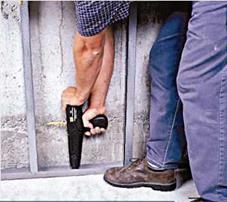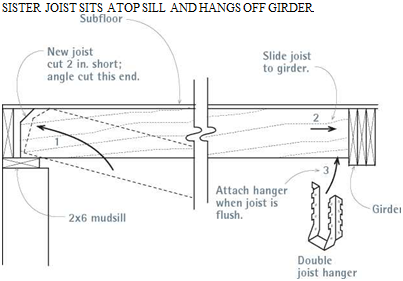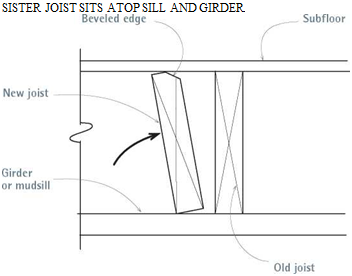Finishing Basement Walls
Basement walls are usually masonry, rarely plumb, and often damp. If you want finished basement walls, here’s a skeletal outline of the principal steps (see Chapter 14 for insulation tips).
1. Eliminate external sources of water such as clogged gutters, inadequate drainage, and improper grading. Repair foundation cracks that could admit water.
2. Trowel or roll a cementitious coating onto foundation walls to damp-proof them. Using construction adhesive, install rigid foam insulation panels to isolate cool foundation walls and prevent condensation. Cover the panels with a plastic waterproofing membrane.
3. Erect wood-frame or light-steel stud walls within—but not touching—
the foundation walls. Use pressure-treated sole plates on wood walls. Or, if space is tight, consider installing 15/s-in.-wide steel studs. (Covered with drywall, they’re sturdy and stable.)
4.  Powder-actuated tools quickly attach sole plates to concrete floors, but such tools are dangerous because most powder loads are the equivalent of a.22 cartridge. Plus you’re shooting steel fasteners into concrete. Get instruction in using these tools safely, read the accompanying safety manuals, and wear appropriate safety equipment— including eye and hearing protection.
Powder-actuated tools quickly attach sole plates to concrete floors, but such tools are dangerous because most powder loads are the equivalent of a.22 cartridge. Plus you’re shooting steel fasteners into concrete. Get instruction in using these tools safely, read the accompanying safety manuals, and wear appropriate safety equipment— including eye and hearing protection.
As furring for basement walls, light-steel studs have advantages: They won’t rot, and 15/o-in.-wide studs don’t waste much space. Here, a powder-actuated tool attaches a metal sole plate to a concrete floor. Because of risks in misusing such tools, follow the manufacturer’s operating instructions exactly.
When a partition runs parallel to the joists, try to position it over a joist so you’ll have something to nail the sole plate to. If you can’t reposition the wall, add blocking between the joists.
or unnecessarily. Moreover, local codes may require a professional.
![]()



 It’s often difficult to tell whether an infestation is active or not. For example, if a subterranean termite infestation is inactive, a prophylactic treatment may suffice. But if the infestation is active, the remedy may require eliminating the conditions that lead to the infestation (such as excessive moisture and earth-wood contact) and an aggressive chemical treatment. Treatment usually consists of applying a chemical barrier on the ground that repels the termites or a "treated zone” whose chemical doesn’t repel them initially but later kills or severely disrupts them.
It’s often difficult to tell whether an infestation is active or not. For example, if a subterranean termite infestation is inactive, a prophylactic treatment may suffice. But if the infestation is active, the remedy may require eliminating the conditions that lead to the infestation (such as excessive moisture and earth-wood contact) and an aggressive chemical treatment. Treatment usually consists of applying a chemical barrier on the ground that repels the termites or a "treated zone” whose chemical doesn’t repel them initially but later kills or severely disrupts them.
Termites, the most famous of insect pests, include drywood, subterranean, and Formosan types. Because subterranean termites need access to the moisture of the soil, they build distinctive dirt tubes up along the surface of foundations. When they eat into the wood, they usually proceed with the grain. Termites swarm in spring or fall. Discourage the return of subterranean termites by lowering soil levels around foundations, footings, and the like.
Drywood termites hollow out chambers separated by thin tunnels and often travel cross-grain; they eject fecal pellets through kick-out holes, forming a pyramid-shaped pile under the holes. Fumigation is effective for drywood termites, but it’s ineffective for treating subterranean termites because their colonies are located in the ground and fumigation gas does not penetrate the soil.
Formosan termites, whose colonies may exceed 1 million individuals, are wreaking havoc along the Gulf Coast of the United States; they live in the ground or in buildings and build huge, hard nests.
Carpenter ants are red or black, ‘/ in. to h in. long. Sometimes confused with termites, these ants have narrow waists and, when winged, wings of different sizes. While they do tunnel in wet or rotting wood, they do not eat it as food and are therefore less destructive than termites. To locate their nests, look for borings rather like coarse sawdust. Professionals will often drill into nests and spray them with an insecticide safe enough for inside use; dusting with boric acid is another common treatment.
Powder-post beetle holes look like tiny BB-gun holes; their borings resemble coarse flour. Because these insects favor the sapwood, evidence of borings may be only superficial until you prod with a pocketknife. Still, holes are not a sure sign of an active infestation. One approach is to remove the damaged wood, sweep up borings, paint the area, and monitor it for a year. If holes reappear, it’s an active
|







Leave a reply